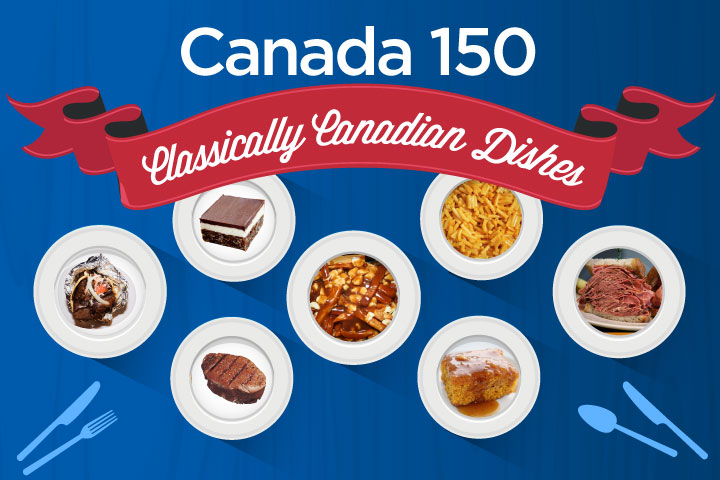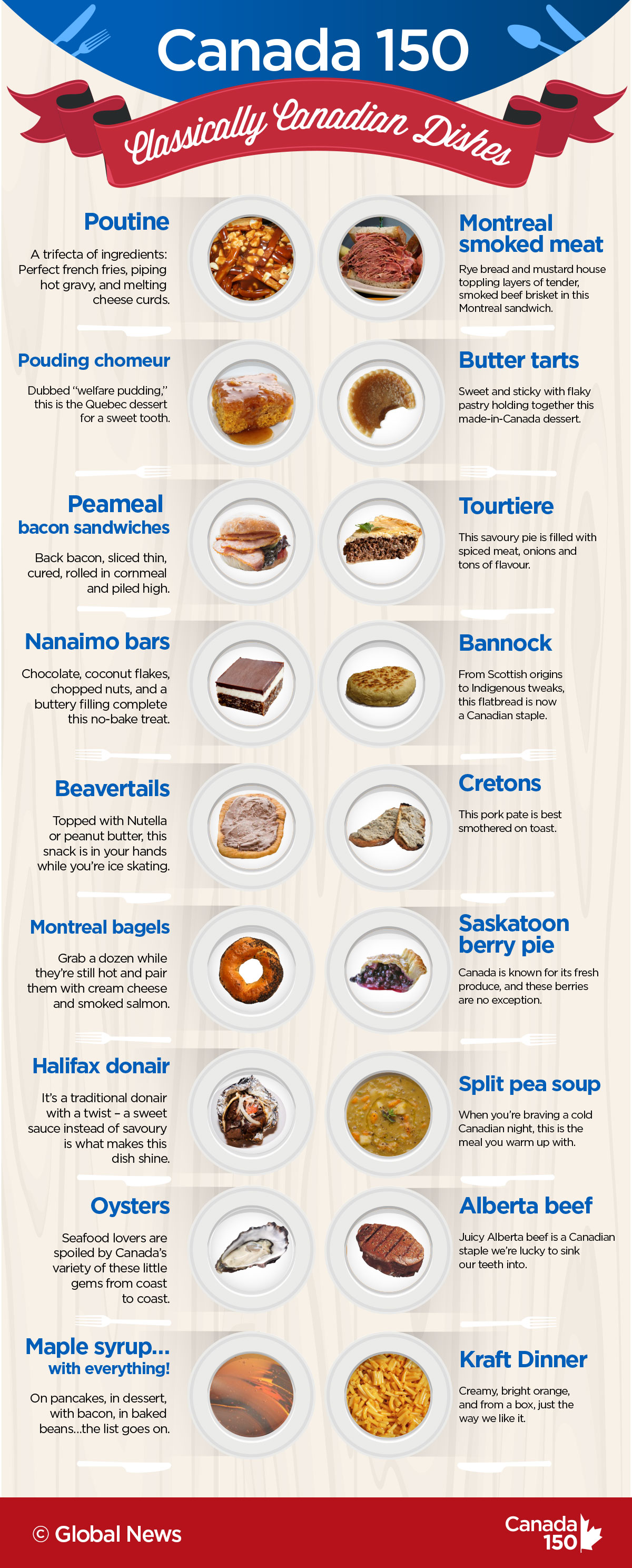Ooey, gooey poutine, smoked meat sandwiches and sticky sweet butter tarts – you know Canada has its fair share of delicious eats.

With a country that spans far and wide, bordering three oceans, it’s no wonder we have a cornucopia of ingredients from Alberta beef to B.C. salmon and P.E.I. potatoes.
But how would you describe Canadian cuisine?
Lenore Newman, a B.C.-based professor and author of cookbook A Canadian Culinary Journey, suggests Canadian cuisine isn’t recipe-based. Instead, it stems from a handful of characteristics.
“We use more wild foods than any other cuisine on earth and it’s seasonal, which is normal for a northern cuisine,” Newman told Global News. Nordic cuisine is seasonal too, for example.
Because our population is so diverse, that multiculturalism shines through, too, according to Rose Murray, author of Canada’s Favourite Recipes. Think of Saskatoon berry perogies – a marriage between Ukrainian and indigenous cooking – or even the California roll, a B.C. chef’s take on a Japanese staple.
READ MORE: Canada 150
It’s regional, too. With such a big country, what you see Canadians serving on the West Coast may be different in the East.
But overall, Canadian dishes shine, Newman said.
“We tend to put our ingredients forward,” Newman said, unlike other cuisines like French or Chinese, which are often doused in sauce.
- Hundreds of public sector workers warned their jobs could be cut: union
- Carney, Trump and Sheinbaum talk trade in Washington at FIFA World Cup draw
- Health Canada recalls glucose monitors that may give ‘incorrect’ readings
- Colleen Jones remembered: Funeral, celebration of life honours famed curler, broadcaster
For some time, the meal served to guests at the Governor General’s home was salmon, fiddleheads and wild rice, Newman noted.
“It’s the quintessential Canadian meal,” she said.
READ MORE: The changing face of Canada, 150 years ago to today
Derek Dammann, Montreal-based chef and author of the cookbook True North, said Canadian cuisine is becoming a defined cuisine of its own.
“We had the ingredients for a long time, but we’re a fairly young country compared to the rest of the world. You’d go to England, France, Spain where there’s a rich culinary identity – eat Italian food, drink Italian wine, and even do it regionally,” Dammann told Global News.
“Well, you can do the same in Canada too, from Quebec, to B.C. and Ontario. We’re lucky,” he said.
Newman, Murray and Dammann, list their favourite iconic Canadian dishes from coast to coast.
(Infographic created by Chris MacDougall/Global News)

Get breaking National news
Butter tarts are sweet and sticky, with flaky pastry holding together the dessert. Inside is a mix of eggs, sugar, butter and vanilla while some people add raisins or chopped nuts into the mix.
They’re made in Canada, too.
“There was a recipe found in an early Canadian cookbook and we assume it’s the first butter tart recipe,” Murray said.
Peameal bacon sandwiches include thin slices of back bacon, cured and rolled in cornmeal and piled high.
They’re a must-have at Toronto’s St. Lawrence Market, but the thing is, outside of Ontario, you won’t see much of Canadian bacon.
“The U.S. somehow thinks we eat a lot of peameal bacon but we don’t know what they’re talking about. It’s funny because tourists come to B.C. and ask for Canadian bacon and we’re like what?” Newman said.
Poutine is the classic Canadian dish that’s garnered worldwide attention. Everyone has their preference on the cut of french fry and type of gravy, but the cheese needs to be squeaky curds.
“It’s pretty well our national dish if we have one,” Newman said.
Poutine emerged out of 1950s Quebec as a cure for hangovers, but it’s evolved since then. Now, depending on where you are in the country, your poutine could be topped with butter chicken in B.C., to sliced Alberta beef, or even lobster on the East Coast, Newman said.
“It’s a nice way to describe Canadian cuisine – we dress it up to meet our region,” she said.
Dammann doesn’t want poutine to be the one-and-only thing Canadians think of when they consider Quebec cuisine though.
“Poutine plays a large role in Quebec’s history and is an iconic Canadian dish but we’re a lot further than that,” he said.
Split pea soup is the dish that warms you up during Canada’s cold winters. The dish originated in Quebec and the East Coast, put together by voyagers who took dried peas with them for a quick meal.
“It was something for travelling men and it’s an old-fashioned Canadian soup,” Murray said.
Pouding chomeur, dubbed welfare pudding, was made by Quebec women during the Great Depression. With cheap ingredients to work with, the cooks got creative whipping up butter, brown sugar, vanilla, milk and flour to create a no-frills cake topped with maple syrup.
“It’s sickeningly sweet and absolutely delicious,” Dammann said.
Nanaimo bars: While Quebeckers grew up on pouding chomeur and tarte a sucre, Dammann, a B.C. native, turned to Nanaimo bars as a child. It’s a no-bake treat out of the Vancouver Island city it’s named after – put together with a layer of chocolate, flaked coconut, walnuts, a middle layer of buttery vanilla custard and another layer of chocolate on top.
“We’d get them on the ferry on the way to a hockey tournament or going to visit grandparents. It was this oversized, delicious Nanaimo bar,” Dammann told Global News.
Bannock is a flatbread originating from Scotland that was adapted by the indigenous people, according to Newman.
Since then, it’s been tweaked and moulded. Now it’s eaten like a taco, filled with toppings like bison, pemmican, other meats and even berry jams or savoury spreads.
Tourtiere is a savoury meat pie out of Quebec filled with ground meat and spices. It’s very unlikely you’ll eat a traditional tourtiere, though – they used to be filled with pigeon with their feet peeking out of the centre of the pie, Newman said.
Beavertails, or Queues de Castor, are deep-fried treats shaped into a beavertail and topped with sweet spreads from Nutella and bananas to peanut butter and M&Ms. They started out in Ontario – you couldn’t skate the Ottawa Canal at wintertime without one in hand – but they’ve spread across the country, including ski resorts in B.C.
Cretons are a pork pate, or spread, out of Quebec. It’s typically made with ground pork, milk, onions, breadcrumbs and other spices and cooked down until it’s a soft texture. It’s delicious on toast or crackers. Murray eats it every year at Canada Day parties.
Montreal smoked meat sandwiches are what tourists and locals graze on when they head to the Quebec city. It’s a kosher-style deli meat made of tender beef brisket that’s been cured with spices. The sandwich is a simple masterpiece: rye bread, mustard and layers of smoked meat.
Montreal bagels are a tasty accompaniment, too. Grab a dozen while they’re still hot from one of the city’s bakers (some are open 24 hours) and pair them with cream cheese, smoked salmon or any of your favourite toppings.
Saskatoon berry pie is close to Murray’s heart. Canada is one of the world’s largest producers of berries from coast to coast but Saskatoon berries grow throughout the Canadian Prairies and even into B.C.
“They have this kind of tart taste to them and they make lovely pies. There’s lots of juice that comes out of them in the process of baking,” Murray said.
Saskatoon berries are nutrition powerhouses, too, packed with antioxidants in the little fruit.
Halifax donair: For some people, donair is their sustenance through university, but have you tried a Halifax donair? It’s the typical dish – spiced meat that’s roasted on a spit and shaved onto your pita, topped with vegetables like tomatoes and raw onions. But the twist is in the sauce. It’s sweet instead of savoury – a mix of milk, vinegar, garlic powder and sugar.
Oysters are an all-time favourite for Canadians who love fresh seafood. We’re lucky, too – oysters come in a variety of shapes and sizes from Canada’s Atlantic and Pacific coasts.
Alberta beef is on the global stage, but you’ll find it across the country prepared in steak dinners, on salads and other dishes. With Canada’s mishmash of cuisines, you could have Alberta beef garnished with Argentinian chimichurri sauce or even find it pan-fried in a Chinese crispy beef dish.
Maple syrup…with everything! Dammann takes his daughter to one of Quebec’s sugar shacks when spring rolls around to get their first taste of the season’s maple syrup. At a cabane a sucre, patrons dine on “copious amounts” of pork and maple syrup – we’re talking about pancakes doused in Canada’s liquid gold, maple bacon, baked beans cooked with pork and maple syrup, cretons, and even fried dough paired with, you guessed it, maple syrup.
“It’s a huge thing here and it’s quite the experience,” Dammann said.
Kraft Dinner, not Mac & Cheese. Newman points to this dish out of a box because it’s likely in every Canadian’s pantry.
“We eat a lot of cheese and Kraft Dinner is very Canadian – we buy a lot of it and we eat a lot of it. It speaks to what we’re like and who we are,” she said.
READ MORE: Canada 150
carmen.chai@globalnews.ca
Follow @Carmen_Chai











Comments